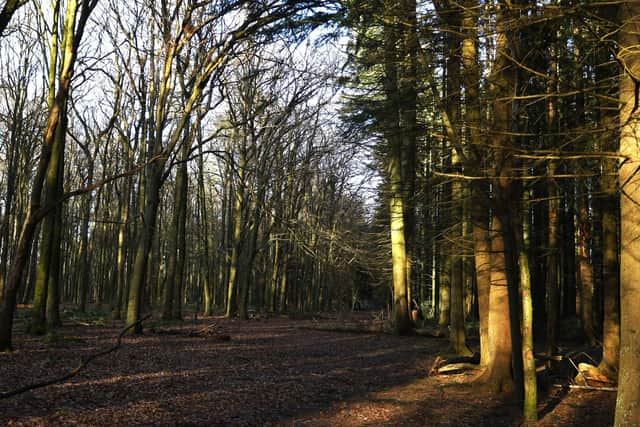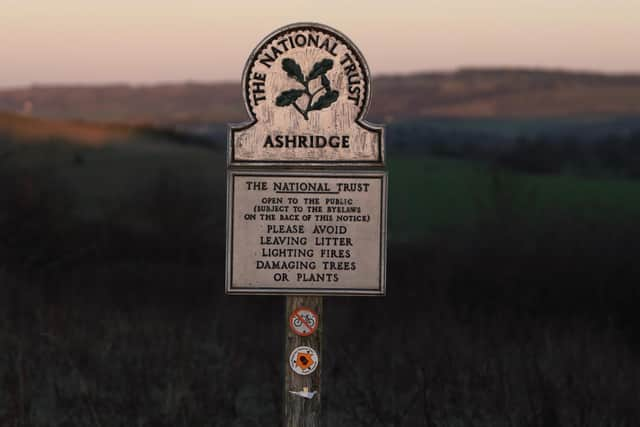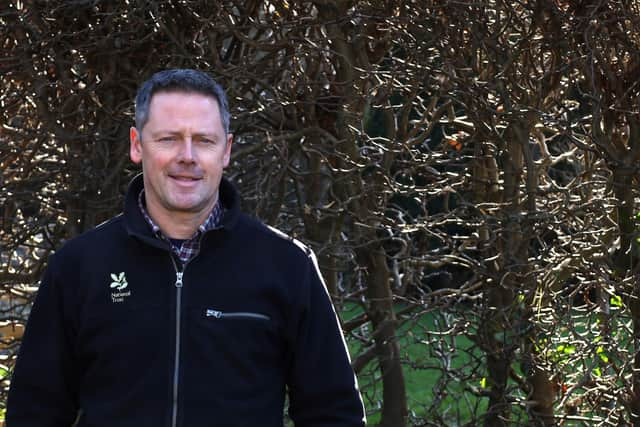Councils urge residents to avoid famous Hertfordshire forest used in movies due to persistent damage
and live on Freeview channel 276
Gnarled oaks and towering beeches have clung onto Chiltern slopes for centuries – but 1.7 million visitors at Ashridge Estate are wearing away the soils which support them.
The ancient woodland near Berkhamsted, Hertfordshire is the real-life enchanted forest from Disney’s Maleficent starring Angelina Jolie, and features on screen in blockbusters including Harry Potter and the Goblet of Fire and Les Misérables with Hugh Jackman.
Advertisement
Hide AdAdvertisement
Hide AdAshridge is the National Trust’s largest ancient woodland, famous for its carpet of bluebells in the springtime.


It takes a team of rangers to keep the forest open to visitors, dogs and horses in a way which protects the animals, fungi, plants and trees which live there.
“Our larger trees are the jewels of our woodland,” said Emily Smith, National Trust countryside manager.
Monument Drive en route to the car park is lined with veteran and notable oaks with trunks more than four metres in circumference.
“Some of these oak trees will be up to about 400 years old.


Advertisement
Hide AdAdvertisement
Hide Ad“Not only are they very beautiful, but they hold a huge amount of rare insects living in the crannies, crevices and the decaying parts of the tree.
“They are really special for a lot of reasons and very prominent in the landscape.
“People walking near them can compact the soil where the roots are, squeezing out the oxygen and water.
“With older trees, that can damage their health and their chance of survival.”


Advertisement
Hide AdAdvertisement
Hide AdOaks around 400 years old are a similar age to Hertfordshire’s Hatfield House – and older than London’s St Paul’s Cathedral.
Some of their branches have started to die, so Emily and the ranger team have built stick hedges to create space for the roots to find untrampled soil and water.
“One of the really special features of an ancient woodland is actually the soil rather than the trees,” Emily said.
“A lot of the trees will have come and gone over 400 years, but what hasn’t changed is the soil where you’ve got a bank of rare and quite special flowers, fungi, invertebrates and microbes that you can’t find anywhere else apart from in a soil with tree cover for that length of time – or longer.”
Advertisement
Hide AdAdvertisement
Hide AdIn the winter months, the footpaths which criss-cross the estate are muddy and wet.
“Some of our visitors try to avoid the wet, but they can end up trampling the vegetation – which damages plants, exposes tree roots and widens the paths for good,” Emily said.
“We’ve always asked people to avoid stepping onto the bluebells in spring when they’re here to take their lovely photographs, but we’ve actually realised a lot of damage is being done in the winter when people are walking around the mud.
“They’re causing compaction of the soil and damaging bluebell bulbs in the winter.
Advertisement
Hide AdAdvertisement
Hide Ad“It’s quite evident in spring when we see those bulbs that have been freshly trampled struggling to survive.”
Dog poo is also a problem for the rangers.
“A lot of the wildlife habitats we look after are so special because they’ve got a rare, low nutrient component to them.
“Rare flowers depend on that low nutrient environment, so dog mess which people think might be biodegradable in the woodland actually increases the nutrient value of the soil, so we see dominant, thuggish plants like nettles growing much faster than they should.
“We ask dog walkers to take their dog mess home with them, rather than ‘stick and flick’ it off the paths.”
‘Something transformational’ needed to mitigate against 32,000 new homes in area
Advertisement
Hide AdAdvertisement
Hide AdAn independent report commissioned by Dacorum Borough Council found almost 500 examples of recreational damage across Ashridge.
After a series of debates and meetings, local authorities are looking at ways to “deflect” visitors from the estate.
“We need to do something transformational to mitigate against the current number of visitors we’ve been seeing,” said Paul Miller, the region’s general manager for the National Trust.
The charity has stopped its programme of public events at Ashridge to focus on a campaign called “Protecting Our Roots”.
Advertisement
Hide AdAdvertisement
Hide AdAlongside maintenance, rangers have begun removing pines from the woodland to replace them with trees native to the Chiltern Hills.
“This is actually quite an exciting time in terms of what we can do to improve the health and biodiversity of the woodland, but it’s also a pivotal point in our history.
“In the 12.6-kilometre (7.8-mile) zone of influence where 75 per cent of our visitors come from, we’re expecting to see up to around 32,000 new homes across four local authorities.
“What we’re doing is thoughtfully working to create a way of dispersing the visitors we currently see into areas that are less designated.
Advertisement
Hide AdAdvertisement
Hide Ad“By putting the right infrastructure in place, we can build an interest in those areas.
“Whilst we’re not saying ‘don’t come’, we’re not encouraging people to come.”
Liberal Democrat councillor Sheron Wilkie, who represents Tring Central, is responsible for “place” at Dacorum Borough Council.
The authority, based in Hemel Hempstead, is using a special levy on housebuilders to set up “suitable alternative natural greenspaces” – at Bunkers Park and Chipperfield Common.
Advertisement
Hide AdAdvertisement
Hide AdIt could also extend Bunkers Park and invest in Gadebridge Park, Howe Grove Wood and Margaret Lloyd Park.
“The idea is that it’s not a prescription per se, but it will provide alternative spaces for dog walkers, people who want to have picnics, and people who want to enjoy open spaces,” said Cllr Wilkie.
“We are not trying to replace Ashridge – we wouldn’t want to.
“We certainly do not expect people to stop going to Ashridge.
“But we can’t carry on as we are.
“Instead, this is a strategy to deal with the issues that are happening with high visitor numbers and putting forward even more natural spaces as alternatives which are just as attractive or better.”